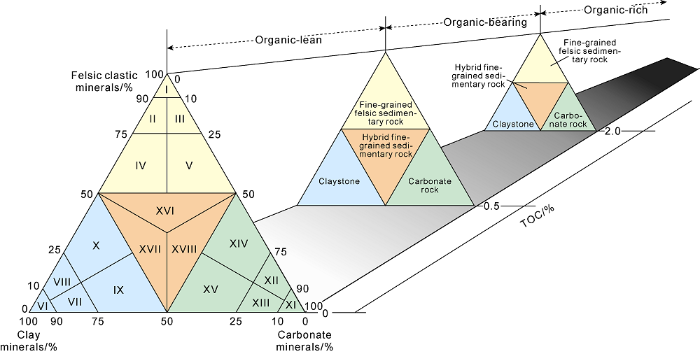Introduction
Fine-grained sedimentary rocks are composed of more than 50% of clay-grade and silt-grade clastic particles less than 62.5 µm in size and account for about 70% of the global sedimentary rocks [1,2,3,4]. Well developed, fine-grained sedimentary rocks in China contain huge oil and gas resources and have broad exploration prospects[5]. In recent years, with the rapid advances in unconventional oil and gas exploration and development, theories and research techniques of fine-grained sedimentology have been used to guide unconventional oil and gas exploration and achieved remarkable results. Considerable reserves of unconventional oil and gas have been proven in the fine-grained sedimentary strata of the Bohai Bay Basin, Ordos Basin, and Sichuan Basin, meanwhile, the yield of unconventional oil and gas has been increasing year by year. Subsequently, the study on fine- grained sedimentary rocks has also drawn more and more attention. But as fine-grained sedimentary rocks are characterized by complex mineral composition and texture, diverse sedimentary structures, complex sedimentary laws, strong heterogeneity, and small sizes of grains difficult to observe [1], concepts of their grain sizes and components are ambiguous, and the boundary between fine-grained sedimentary rocks and hybrid rocks is not clear, the classification and nomenclature schemes of fine-grained rocks are inconsistent. Moreover, the existing classification scheme can not accurately reflect petrological characteristics of fine-grained sedimentary rocks, severely restricting the understanding of sedimentary environment, sedimentary laws and reservoir characteristics of fine-grained sedimentary rocks [2], thereby hindering the progress of unconventional oil and gas exploration to some extent [1,2,3,4,5]. In view of this, based on previous research results, guided by the theory of sedimentary petrology, taking fine-grained sedimentary rocks as the research object, we have reorganized and defined related concepts of fine-grained sedimentary rocks, on this basis, come up with a new scheme for classification and nomenclature of fine-grained sedimentary rocks from petrological characteristics in this work.
1. Classification of fine-grained sedimentary rocks and current status of nomenclature schemes
There is currently no unified and clear classification and nomenclature scheme for fine-grained sedimentary rocks, which has both objective and subjective causes. Objectively, there rocks are diverse in material composition, occurrence and texture, and complex and diverse in rock type and vertical superposition relationship [6]. For instance, their common mineral components include clay and felsic minerals, carbonate minerals, organic matter, pyrite, and gypsum etc. They come in mass, strip, lamina, and sheet occurrences. They have different types of laminae, such as straight, wavy, continuous, and intermittent ones. As fine-grained sedimentary rocks are very small in particle size, it is difficult to accurately determine the composition, content, and rock structure type of them by conventional observation of field outcrop and core, and microscopic identification of ordinary thin section [7]. Unconventional analysis and technical means are often resorted to identify fine-grained sedimentary rocks. The subjective cause is that the definition of fine-grained sedimentary rock has not been unified in the academic world. Scholars have carried out relevant researches based on their own understanding of fine-grained sedimentary rocks, and therefore come to different understandings and conclusions.
1.1. Classification and nomenclature factors
The major bases for the classification and nomenclature of fine-grained sedimentary rocks include composition, grain sizes, and contents of minerals, sedimentary structure, laminar morphology, organic matter, color, and special mineral components etc.
The mineral composition is jointly controlled by terrestrial input, sedimentation and diagenesis. During diagenesis, the rock will be affected by physical, chemical, and biological processes, which is the root cause of diversity of rock types [8,9]. Grain size is the most important structural characteristic of clastic particles in sedimentary rock and is also an important parameter for the classification of rock type. The grain size of sedimentary rock can reflect the provenance distance, hydrodynamic conditions, bathymetric condition and other sedimentary environment factors [10]. Sedimentary structure is one of the most common macroscopic characteristics of fine-grained sediments, and the formation of sedimentary structures is closely related to the transportation way, deposition rate, deposition mode and hydrodynamic conditions of the sediment [11]. The color, the most striking sign of fine-grained sedimentary rock, mainly reflects the mineral composition, sedimentary environment, and provenance characteristics of the rock.
1.2. Application of classification and nomenclature scheme
The classification and nomenclature of fine-grained sedimentary rocks are generally based on the conventional nomenclature method of clastic rocks, that is, according to the particle size characteristics of rock particles, the rocks are classified and named according to the principle of three-level nomenclature. On this basis, elements such as composition and genesis are considered.
Table 1 Classification and nomenclature schemes of fine-grained sedimentary rocks in China and abroad
| Scholars | Year | Study object | Classification basis | Classification result | References |
|---|---|---|---|---|---|
| Loucks et al. | 2007 | Fort Worth Basin | Mineral composition, biological characteristics | Laminar siliceous mudstone, laminar clay-bearing limy mudstone, framework clay-bearing limy mudstone | [12] |
| Alexandre et al. | 2012 | Jurassic in the Dutch Central Graben | Sedimentary structures, types of laminae | Bioturbation silty mudstone, thin-layered mudstone, wavy laminated mudstone, thin-layered wavy laminated mudstone | [13] |
| Wang | 2012 | Paleogene in Jiyang Depression | Lamina type | 7 types, including black shale, limestone, mud shale, etc. | [14] |
| Jiang et al. | 2013 | Lacustrine fine-grained sedimentary rocks | Organic matter, mineral components | Siltstone, claystone, carbonate rock and hybrid fine-grained sedimentary rock | [1] |
| Yan et al. | 2015 | The Paleogene Kong 2 Member in Cangdong Sag | Special mineral component analcime | Analcime-containing dolomite fine-grained felsic sedimentary rock, analcime-containing dolomite, analcime-containing dolomite fine-grained hybrid sedimentary rock, etc. | [7] |
| Lazar et al. | 2015 | Cenomanian-Turonian Eagle Ford Shale of south Texas | Particle size, components, genesis | Fine-grained mudstone, medium-grained mudstone and coarse-grained mudstone; calcareous mudstone, siliceous mudstone, clayey mudstone | [15] |
| Ran et al. | 2016 | Ordovician Wufeng-Silurian Longmaxi Formation in Sichuan Basin | Quartz content and laminar morphology | Silicon-rich unparalleled laminar shale, medium- silicon inconspicuous laminar shale, etc. | [16] |
| Zhang et al. | 2018 | Permian Lucaogou Formation in Jimusaer Sag | Mineral composition, genesis, volcanic debris | Endogenous sedimentary rock, pyroclastic sedimentary rock, terrigenous clastic rock and hybrid rock | [17] |
| Liang et al. | 2018 | Upper Sub-member of Paleogene Shahejie Formation in the Bohai Bay Basin | Mineral components, organic matter | Oil shale, organic-rich calcareous shale, carbonate- bearing silty shale, organic-lean anhydrite shale | [18] |
| Li et al. | 2021 | Paleogene Shahejie Formation in the Dongying Sag | Mineral components, organic matter, layer type | Horizontal organic matter laminar mudstone, convoluted laminated dolomitic mudstone, massive bauxite mudstone, softly-deformed organic matter laminar argillaceous limestone | [19] |
| Li et al. | 2020 | Kong 2 Member in Cangdong Sag | Sedimentary structure, special minerals | Massive analcime lime dolomite fine-grained sedimentary rock, laminar analcite felsic fine-grained sedimentary rock, massive uniform fine-grained sedimentary rock | [4] |
| Zhang et al. | 2021 | Lower sub-member of the third member of Paleogene Shahejie Formation in Zhanhua Sag, Bohai Bay Basin | Sedimentary structure, genetic mechanism | Algal limestone, laminar marl, laminar recrystallized limestone, laminar limy mudstone and massive limy mudstone | [20] |
Foreign studies on fine-grained sedimentary rocks mainly focus on marine siliceous-rich fine-grained sedimentary rocks. Loucks [12] analyzed mineral petrological characteristics of marine shale layers in the FortWorth Basin of the United States, named the rocks based on mineral composition, texture, biological characteristics, grain size, and color, and established a lithofacies classification scheme. Taking sand, coarse mud and fine mud as three end members, Lazar [15] divided fine-grained sedimentary rocks into six types, namely, sandstone, argillaceous sandstone, sandy mudstone, coarse-grained mudstone (i.e. siltstone), medium-grained mudstone (i.e. mudstone), and fine mudstone (i.e. clay rock) (Fig. 1).
Fig. 1.
Fig. 1.
Nomenclature scheme of fine-grained sedimentary rocks (modified according to reference [15]).
In line with the mineral composition characteristics of marine shale formations in southern China and lacustrine fine-grained sedimentary rocks in eastern China, clay minerals, clastic minerals, and carbonate minerals are commonly used as three end members at present to classify fine-grained sedimentary rocks into 4 types, mudstone or clay, siltstone, carbonate rock with clay minerals, clastic minerals, and carbonate minerals accounting for more than 50% respectively, and hybrid fine-grained sedimentary rock with all the 3 components accounting for less than of 50% [1, 8, 21]. This classification scheme is widely used and has good applicability. But the authors think that the scheme will be more clear and scientific if the three end members are unified into grain size or mineral composition, and this way can also reduce the complexity of classification and nomenclature of fine-grained sedimentary rocks. To date, some researchers have unified the mineral components of the three end members for the nomenclature, and replaced the grain-level "silt sand" with "felsic debris" component in juxtaposition with clay minerals and carbonate minerals [4-5, 22]. Due to different characteristics of sedimentary environments of fine-grained sedimentary rocks in different regions, some researchers have added organic matter content, sedimentary structure, special minerals, and the likes to the classification and nomenclature of rocks based on regional conditions [6, 22-23].
1.3. Existing problems
Scholars have achieved fruitful research results on the classification, nomenclature, and lithofacies of fine-grained sedimentary rocks, which has greatly enriched people’s understanding on these rocks and promoted the advancement of unconventional oil and gas exploration and development. But there are still many aspects that need to be considered and improved, primarily including: (1) The concepts of fine-grained sedimentary rock and hybrid rock are confusing. Hybrid rock refers to the rock with characteristics of multi-material components formed by terrigenous clastics and carbonate and other mineral particles through alternating or uniformly hybrid sedimentation [24,25]. There are mainly two differences between hybrid rocks and fine-grained sedimentary rocks: one is that hybrid rocks have no grain size restriction; the other is that hybrid rocks stress more on hybrid sedimentation. If the materials less than 62.5 µm in grain size in the hybrid rock are more than 50% in volume, the hybrid rock belongs to fine-grained sedimentary rock and can be called hybrid fine-grained sedimentary rock, that is, fine-grained hybrid rock. (2) When the 3 end members are used to classify or name rocks, mineral component and grain grade are often taken as paratactic bases for classification, or the TOC and mineral components are taken as paratactic bases, not only making it difficult to unify the nomenclature and classification of rocks, but also making the study on petrological characteristics, sedimentation and genetic law of fine-grained sedimentary rocks difficult. (3) The concepts of mud and clay are confused. Mud is the concept of particle size, while clay indicates clay minerals. It should be noted that mud-sized debris is extremely rare, therefore there is hardly any lithic debris in pure mudstone. (4) According to mineral composition characteristics of the rock, argillaceous rock with a clay mineral content of more than 50% should be referred to as clayey rock, that is clay rock. From the perspective of mineral composition and structural characteristics, clay rock is a special type of argillaceous rock. Clay rock is the same as siliceous rock and calcareous rock. The meaning of "clay" herein is completely different from that in the three-level nomenclature of rocks. The former refers to a type of rock with a mineral content greater than 50%, and the latter means that the content of clay minerals or structural component in the rock is 25%-50%. These are two terms in different application systems which need to be distinguished in the practical application.
2. Bases for classification and nomenclature of fine-grained sedimentary rocks
Grain grade is the attribute parameter of fine-grained sedimentary rock, and material composition is the fundamental element for studying characteristics of fine-grained sedimentary rock. This paper discusses the classification and nomenclature scheme of fine-grained sedimentary rocks from these two elements, grain size and material composition.
2.1. Grain grade
Regarding the particle size classification of fine-grained sedimentary rocks, currently there are two division schemes and classification standards commonly used in China. One is Udden-Wentworth's geometric progression of 2 [26], which is widely used internationally. The other is the decimal grain grading scheme [26]. Easy to remember and apply, and meeting the basic requirements of oil and gas reservoir research, this scheme is widely used in the Chinese petroleum industry (Table 2).
Table 2 Classification and nomenclature of grain grades (modified according to reference [26])
| Grain diameter/mm | Clastics in clastic rock | Clastics in carbonate rock | Crystal grains in carbonate rock | |
|---|---|---|---|---|
| Decimal grading scheme | 2 geometric progression scheme | |||
| Larger than 2.0 | Larger than 2.0 | Conglo- merate | Conglomerate debris | Conglomerate crystal |
| 0.1-2.0 | 0.062 5-2.000 0 | Sand | Arenaceous | Sand crystal |
| 0.005-0.1 | 0.003 9-0.062 5 | Silt | Powder debris | Powder crystal |
| Smaller than 0.005 | Smaller than 0.003 9 | Mud | Mud debris | Mud crystal |
As shown in Table 2, through the study of hydraulic properties, researchers found that particles smaller than 0.0625 mm in size were too small to be distinguished by the naked eye due to the sharp increase in clay material. Therefore, the criterion of 0.0625 mm is recommended as the boundary between sand and silt. If the decimal classification is used, that is, the second division scheme, the boundary between sand and silt is set at 0.1 mm to facilitate the study of oil and gas reservoirs. Because good oil and gas reservoirs are mostly above fine sand in grain grade (with particle sizes of 0.10-0.25 mm or more). The boundary between silt and mud is 0.0039 mm in the geometric progression scheme of 2. This division scheme considers that mud-grade mineral particles are fine, generally less than 0.004 mm in size. That boundary in the decimal scheme is 0.005 mm, that is, the upper limit of the particle size at which clay minerals begin to appear is taken as the boundary.
Fine-grained sedimentary rock is mainly defined from the perspective of particle size of the sediment, which is subdivided into siltstone and argillaceous rock. Fine- grained sedimentary rock corresponds to silt and mud grain grades in the clastic rock, and powder crystal grade and micrite grade in carbonate rock (Table 2). Therefore, silt-grade carbonate rock is equivalent to siltstone in fine-grained sedimentary rocks, and micrite-grade carbonate rock is equivalent to mudstone in fine-grained sedimentary rocks.
2.2. Material composition
Table 3 Material composition of fine-grained sedimentary rocks in typical regions
| Basin type | Area | Felsic clastic content/% | Carbonate content/% | Clay content/% | Organic matter content/% | Special mineral content/% | Refe- rences |
|---|---|---|---|---|---|---|---|
| Marine | Barnett shale in Fort Worth Basin, U.S. | 51.9 | 8.1 | 35.0 | 4.5 | Pyrite 4.1 | [27] |
| Upper Jurassic Haynesville shale in U.S. Gulf Basin | 31.8 | 22.7 | 45.5 | Pyrite 3.2 | [28] | ||
| Devonian-Mississippi fine-grained sedimentary rocks in Western Canada Sedimentary Basin | 11.1-92.5 48.9 | 0.1-85.4 4.7 | 0.1-88.3 45.9 | 0.1-5.7 1.3 | Pyrite 0.5 | [29] | |
| Silurian Long-1 Sub-member shale in the Sichuan Basin, SW China | 39.5-61.4 49.7 | 6.3-34.5 12.7 | 18.6-47.0 34.9 | 2.3-5.5 3.6 | [30] | ||
| Fine-grained sedimentary rocks of the Upper Permian Longtan Formation in the Southeastern Hunan Depression, China | 9.0-43.0 27.0 | 23.0-50.0 38.0 | 25.0-41.0 35.0 | 0.2-7.4 2.1 | Pyrite 2.0 | [31] | |
| Fine-grained sedimentary rocks of Cambrian Yu’ertusi Formation in Tarim Basin | 21.2-94.8 57.8 | 0.1-69.6 16.9 | 0.8-48.5 15.7 | 0.1-8.6 2.4 | Pyrite 2.2 | [32] | |
| Continental | Fine-grained sedimentary rocks of the Lower Jurassic Da'anzhai Member in the Sichuan Basin, SW China | 15.3-66.2 36.9 | 0.1-95.0 20.9 | 9.0-56.0 24.3 | 1.1 | [33] | |
| Fine-grained sedimentary rocks of the Paleogene Sha 3-Sha 4 Member in Dongying Sag, Bohai Bay Basin | 1.0-62.0 23.8 | 1.0-91.0 50.6 | 1.0-70.0 20.3 | 0.1-13.6 2.5 | Pyrite 2.7 | [34] | |
| Fine-grained sedimentary rock in the second member of Paleogene Kongdian Formation in Cangdong Sag, Bohai Bay Basin | 0.1-56.0 36.7 | 0.1-95.0 32.8 | 1.0-56.0 15.1 | 0.1-13.1 3.4 | Cubicite 14.8 | [35] | |
| Fine-grained sedimentary rocks of Permian Lucaogou Formation in Junggar Basin | 0.1-73.5 49.4 | 0.1-91.5 36.9 | 0.1-15.0 11.9 | Pyrite 1.0 | [17] | ||
| Fine-grained sedimentary rocks of the first member of Cretaceous Qingshankou Formation in Songliao Basin, SW China | 3.7-73.4 49.4 | 0.1-93.5 13.1 | 2.5-49.6 33.6 | 0.5-6.8 3.2 | Pyrite 3.9 | [36] |
Note: The numerator is the range, and the denominator is the average.
Felsic minerals in fine-grained sedimentary rocks come from multiple sources, including terrestrial input, chemical origin, and biological origin. Rich silica of the American Barnett marine shale and the Silurian Longmaxi Formation marine shale in the Sichuan Basin (with mineral content exceeding 50%) (Table 3) is mainly due to the influence of siliceous sponges and radiolarians etc siliceous organisms [27, 30]. The lacustrine fine-grained sedimentary rocks in the fourth member of the Paleogene Shahejie Formation, the Dongying Sag often contain terrigenous clastic minerals such as quartz [23]. It is generally believed that biogenic quartz is more brittle than terrigenous quartz [37], therefore the higher the content of biogenic quartz, the more favorable it is for the exploration and development of oil and gas reservoirs in fine-grained sedimentary rock.
Fine-grained sedimentary rocks are often rich in carbonate minerals, the formation of which is closely related to chemical and microbial processes [38,39,40,41]. For example, the Upper Jurassic Haynesville marine shale in the Gulf of Mexico Basin, the Upper Permian Longtan Formation marine fine-grained sedimentary rock in the Southeastern Hunan Depression, and fine-grained sedimentary rocks of the Paleogene Shahejie Formation in the Dongying Sag of the Bohai Bay Basin have average carbonate mineral contents of 22.7% [28], 38% [31] and over 50% [34] respectively (Table 3).
Marine fine-grained sedimentary rocks have higher contents of clay minerals than deep lacustrine fine-grained sedimentary rocks. For example, the Devonian-Mississippian marine fine-grained sedimentary rocks in the western Canada sedimentary basin have an average content of clay minerals of over 45% [29]; while lacustrine fine-grained sedimentary rocks have an average content of clay minerals of about 20% (Table 3), this is mainly because continental basins are smaller in size, and the fine-grained sedimentary rocks in them are closer to provenance areas [42].
Organic matter is commonly seen in fine-grained sedimentary rocks. For example, the Barnett marine shale in the Fort Worth Basin of the United States, the lacustrine fine-grained sedimentary rock in the second member of Paleogene Kongdian Formation in Cangdong Sag, and fine-grained sedimentary rocks of the first member of Cretaceous Qingshankou Formation in the Songliao Basin have average TOC contents of 4.5% [27], 3.4% [35], and 3.2%[36], respectively; the marine fine-grained sedimentary rocks of the Cambrian Yuertusi Formation in the Tarim Basin has a TOC up to 8.6% [32] (Table 3). The organic matter of mud grade in fine-grained sedimentary rocks mainly comes from dissolved organic matter and microorganisms such as algae [43], and is often stored in a variety of ways, such as organisms, biological residues, and amorphous body [44].
Pyrite often has low content in fine-grained sedimentary rocks, but has great significance in indicating the depositional environment. The marine fine-grained sedimentary rocks of the Cambrian Yuertusi Formation in the Tarim Basin have an average pyrite content of 2.2% [32], and the lacustrine fine-grained sedimentary rocks of the first member of Cretaceous Qingshankou Formation in the Songliao Basin have an average pyrite content of about 3.9% [36] (Table 3). Studies have shown that the formation of pyrite is closely related to the deep sea environment, and can be used for provenance tracing, stratigraphic division and correlation, and identifying environmental variation and estimating deposition rate[45,46].
3. New scheme for classification and nomenclature of fine-grained sedimentary rocks
In this study, taking fine-grained sedimentary rocks of the Shahejie Formation in the Dongying Sag of the Bohai Bay Basin as research object, particle sizes and mineralogical composition of major rock types were tested by technical methods such as microscopic identification of thin sections, granulometric analysis, whole rock mineral X-ray diffraction, and clay mineral X-ray diffraction etc. Based on the test results, two sets of new classification and nomenclature schemes have been proposed.
3.1. Principles of classification and nomenclature
(1) According to the grain size grade, from gravel, to sand, silt, and mud, the principle of "mud-grade mineral content + silt-grade mineral content" greater than 50% is used to determine whether the rock is fine-grained sedimentary rock.
(2) On this basis, according to the relative content of mud and silt, the fine-grained sedimentary rock is divided into mudstone and siltstone. The rest grain sizes are merged into two major grades, gravel and sand, and then named according to the principle of three-level nomenclature. Or the fine-grained sedimentary rock is classified into clay rock, carbonate rock, and fine-grained felsic sedimentary rock based on the mineral composition, and the rest components are still classified and named according to the three-level nomenclature principle.
(3) Since the rock with gravel-grade mineral content greater than 30% is named conglomerate, which does not conform to the principle of three-level nomenclature, therefore, gravel-grade minerals are not used as the major end members in this scheme, but the content of gravel minerals should be considered in practical application.
(4) After the basic name of fine-grained sedimentary rock is determined by the three-level nomenclature, if some material components less than 10% in contents have some special indicating significance, for example, analcime can indicate brittleness of the rock or pyrite can indicate the redox environment, these components can also be added to the nomenclature according to specific situation. In addition, modifiers such as sedimentary structure, color and microstructure can be added in the nomenclature.
3.2. Classification and nomenclature by grain size
The sand-grade mineral, silt-grade mineral and mud- grade mineral are regarded as the three-end members of the fan shape, and the fine-grained sedimentary rocks are classified and named according to the principle of three-level nomenclature.
3.2.1. Classification and nomenclature scheme by grain size
The basic name of the rock is determined based on the size of grains accounting for more than 50%, that is, the basic name "×× rock". Since the particles of fine-grained sediments are less than 62.5 μm, the fine-grained sedimentary rock can be divided into two basic types, mudstone and siltstone. According to the contents of remaining grains, the grains with a content of 25%-50% are written in the form of adjective "××" before the basic name. The grains with contents of 10%-25% are used as secondary adjectives, written at the first in the form of " ××-bearing ". The grades of grains of less than 10% in content are not reflected in the nomenclature of the rock.
According to the abovementioned scheme, the content of silt-grade and clay-grade minerals are firstly defined at 0-100%. Since the content of sand-grade minerals in fine-grained sedimentary rocks does not exceed 50%, the content of sand-grade minerals is defined at 0-50% to determine the ranges of the three end members in the sector graph of granular nomenclature. Finally, 12 rock types in two categories, siltstone dominated by silt-grade minerals, and mudstone dominated by mud-grade minerals are classified (Fig. 2).
Fig. 2.
Fig. 2.
The sector diagram of classification and nomenclature of fine-grained sedimentary rocks. I—pure siltstone; II—silt-bearing siltstone; III—argillaceous siltstone; IV— silty mudstone; V—silt-bearing mudstone; VI—pure mudstone; VII—clay-bearing siltstone/sand-bearing siltstone; VIII—sand-bearing argillaceous siltstone; IX—sand-bearing silty mudstone; X—silt-bearing mudstone/sand-bearing mudstone; XI—clay-bearing sandy siltstone/sandy siltstone; XII—silt-bearing sandy mudstone/sandy mudstone.
3.2.2. Application of the scheme
The test and analysis results of fine-grained sedimentary rocks of Shahejie Formation in Dongying Sag are taken as an example to illustrate the application of this scheme.
(1) If the rock contains more than 60% of mud-grade minerals and more than 30% silt-grade minerals, it is named silty mudstone (IV) (Table 4).
Table 4 Macroscopic and microscopic characteristics of typical fine-grained sedimentary rocks in the fourth member of the Paleogene Shahejie Formation, Dongying Sag
| No. | Rock type | Macroscopic features | Microscopic features | |
|---|---|---|---|---|
| 1 | Silty mudstone |  |  |  |
| 2 | Mud-bearing sandy siltstone |  |  |  |
| 3 | Silt-bearing mudstone/ silt-bearing muddy calcite mudstone/silt-bearing argillaceous micritic limestone | 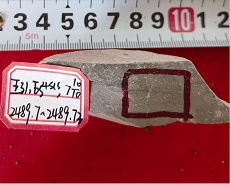 | 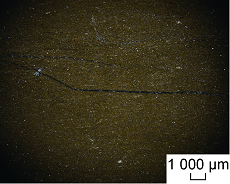 | 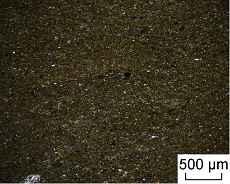 |
(2) If the rock contains more than 65% silt-grade minerals and 25%-35% mud-grade minerals, it is named argillaceous siltstone (Ⅲ).
(3) If the rock contains 62% silt grade minerals, 26% sand-grade minerals, and 12% mud-grade minerals, it is called clay-bearing sandy siltstone (XI) (Table 4).
(4) If the rock contains 57% clay-grade minerals, 26% silt-grade minerals, 6% sand-grade minerals, and 11% gravel minerals, it is named gravel-bearing silty mudstone.
(5) If mineral components need to be emphasized in the nomenclature according to the grain grade, the mineral names are put before the corresponding grain grades as modifiers. For example, if a mudstone sample has greater than 50% of calcite grains in mud-grade, more than 28% silt-grade quartz grains, and 15% sand-grade minerals, it is named sand-bearing quartz silty calcite mudstone or sand-bearing quartz silty micritic limestone.
(6) If a rock sample contains two types of mud-grade minerals at the same time, and the mineral components needs to be emphasized, the component more than 50% in content is taken as the basic name, and the other one is still based on the nomenclature principle of "×× adjective" or " ××-bearing". For example, if a rock sample has 53% mud-grade calcite, 28% clay minerals such as kaolinite, and 13% silt-grade quartz, according to the grain grade, it is named silt-bearing mudstone (V); if the primary component is emphasized, it can be called silt-bearing argillaceous calcite mudstone or silt-bearing argillaceous micritic limestone (Table 4).
(7) The rocks mainly composed of carbonate minerals (content greater than 50%) of less than 0.003 9 mm in size belong to the category of mudstone in fine-grained sedimentary rocks. For example, micritic limestone and micritic dolomite can be named as limy mudstone/calcite mudstone, dolomitic mudstone/dolomitic mudstone. But considering the current practical application and general applicability, these rocks are still classified as carbonate rocks and called micritic limestone or micritic dolomite etc.
Therefore, mudstone can be defined as rocks dominated by mud-grade felsic minerals and clay minerals, such as quartz mudstone, feldspar mudstone, clay mudstone/clay rock etc. That is, when the clay mineral content in the mudstone is greater than 50%, it is called clay rock; when the calcite content is greater than 50%, it is called micritic limestone; when the dolomite content is greater than 50%, it is called micritic dolomite. Quartz mudstone and feldspar mudstone must exist in theory, but since these two minerals are mainly derived from terrigenous debris formed by weathering, considering the weathering nature, they are difficult to enriched to 50% in the form of mud-grade particles, therefore they are rare in nature.
(8) The argillaceous rock with leaf texture is called shale. Shale and mudstone are divided according to sedimentary structure. The term mud shale blurs the differences between the two in sedimentary structure, and the two should be distinguished.
3.3. Classification and nomenclature by components
Since the concept of fine-grained sedimentary rock has limited the grain grades, the difference in composition should be paid more attention to when conducting classification and nomenclature. Therefore, when classifying and naming fine-grained sedimentary rocks according to components, collectively referring the detrital mineral particles of slit size as "felsic mineral" is more appropriate. Hence, based on the relative percentages of carbonate minerals, felsic detrital minerals and clay minerals, fine-grained sedimentary rocks are classified and named according to the three-level nomenclature principle.
3.3.1. Classification and nomenclature scheme by components
The basic name of the rock is determined by the mineral component more than 50% in content, that is, the basic name "×× rock". The mineral components 25%-50% in content are written before the basic name in the form of the adjectives "××"; the components 10% to 25% in contents are used as secondary adjectives, written in the form of "××-bearing" at the head. Mineral components less than 10% in content are generally not involved in the nomenclature.
Fine-grained sedimentary rocks are complex in mineral composition. If no components have a content of more than 50%, and two or more mineral components have contents of 25%-50% in a rock sample, then the rock sample can be named by the compound of the components with contents of 25%-50%, and expressed in the form of "××-××-textured hybrid fine-grained sedimentary rock", and the components with higher contents are written at the back. Other mineral components with lower content are still dealt according to the principle of three-level nomenclature.
If a fine-grained sedimentary rock sample not only has no mineral components more than 50% in content, but also has no or only one component with a content of 25%-50%, all the mineral components of the rock can be combined into felsic and clayey, iron, lime and dolomite, and then expressed in the form of "××-textured hybrid fine-grained sedimentary rock" or " ××-××-bearing hybrid fine-grained sedimentary rock".
According to the above principles, the rock with more than 50% clay minerals called clay rock; the rock with more than 50% calcite/dolomite is called limestone/ dolomite, also known as carbonate rock; the rock with more than 50% felsic clastic minerals is called fine-grained felsic sedimentary rock; when the contents of these three minerals are all less than 50%, the rock is called "××-textured hybrid fine-grained sedimentary rocks". Finally, the fine-grained sedimentary rocks are divided into 18 types in four major categories (Fig. 3). Among them, if the feldspar in a rock sample is less than 10%, it isn’t included in the nomenclature, and the rock is called fine-grained quartz sedimentary rock. Similarly, if the quartz in a rock is less than 10%, it is not involved in the nomenclature and the rock is called fine-grained feldspar sedimentary rock.
Fig. 3.
Fig. 3.
Triangular diagram of the nomenclature of fine-grained sedimentary rocks. I—fine-grained felsic sedimentary rock; II—clay-bearing fine-grained felsic sedimentary rock; III—lime-bearing/dolomite-bearing fine-grained felsic sedimentary rock; IV—clayey fine-grained felsic sedimentary rock; V—limy/ dolomitic fine-grained felsic sedimentary rock; VI—pure clay rock; VII—lime-bearing/dolomite-bearing clay rock; VIII—felsic-bearing clay rock; IX—limy/ dolomitic clay rock; X—felsic clay rock; XI—pure carbonate rock; XII—felsic-bearing carbonate rock; XIII—clay-bearing carbonate rock; XIV—felsic carbonate rock; XV—clayey carbonate rock; XVI—felsic hybrid fine-grained sedimentary rock; XVII—clayey hybrid fine-grained sedimentary rock; XVIII—limy/dolomitic hybrid fine-grained sedimentary rock.
In addition, fine-grained sedimentary rocks are closely related to shale oil and gas, and an important controlling factor for the shale oil and gas enrichment and high yield is the content of organic carbon [47,48]. Organic carbon content must be taken as an important parameter when conducting nomenclature. Previous studies have confirmed that from the perspective of hydrocarbon accumulation, fine-grained sedimentary rocks with TOC of more than 0.5% have good oil and gas geological significance [49,50], and fine-grained sedimentary rocks with TOC of more than 2.0% can yield industrial production of oil and gas [51]. Fine-grained sedimentary rocks are classified into three types, organic-lean, organic-bearing, organic- rich by taking TOC values of 0.5% and 2.0% as dividing points. The parallel triangle diagram of 4-component classification system by Pettijohn [26] was employed to include TOC in the nomenclature (Fig. 3).
3.3.2. Application of the scheme
The application of this scheme is also illustrated by taking the fine-grained sedimentary rocks of the Shahejie Formation in the Dongying Sag as an example.
(1) The rock with 60% powder crystalline calcite, 2% dolomite, 26% clay, and TOC of more than 2% is named as organic-rich clayey carbonate (XV), but if granular grade is emphasized, it is named organic-rich clayey powder crystalline limestone (Table 5).
Table 5 Distribution characteristics of material components of typical fine-grained sedimentary rocks in the fourth member of the Paleogene Shahejie Formation in Dongying Sag
| No. | Rock type | Macroscopic characteristics | Microscopic characteristics | Contents of minerals/% | TOC/% |
|---|---|---|---|---|---|
| 1 | Organic-rich clayey carbonate rock/ organic-rich clayey silty limestone |  | 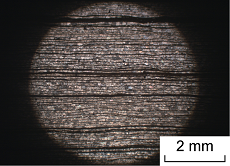 | 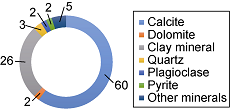 | > 2 |
| 2 | Organic-lean silt- bearing clayey carbonate rock/organic-lean silt-bearing clayey micritic limestone | 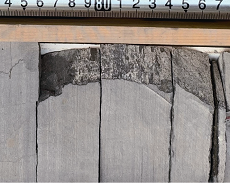 | 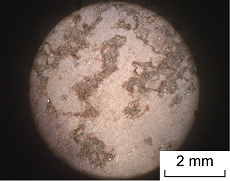 |  | < 0.5 |
| 3 | Organic-bearing felsic limy claystone | 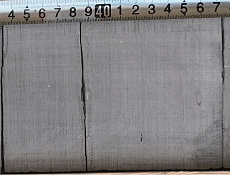 | 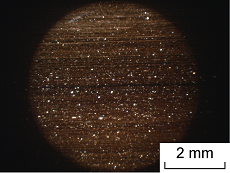 | 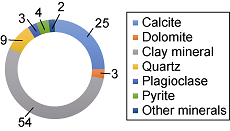 | 0.5-2.0 |
| 4 | Organic-hybrid dolomitic hybrid fine-grained sedimentary rock |  | 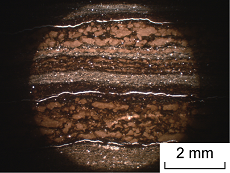 | 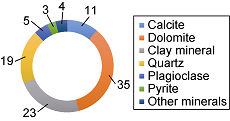 | < 0.5 |
(2) The rock with 53% micritic calcite, 3% dolomite, 27% clay minerals, 7% quartz, 5% feldspar, and TOC of less than 0.5% is named as organic-lean silt-bearing clayey carbonate rock or organic-poor silt-bearing clayey micritic limestone (Table 5).
(3) The rock with 30% kaolinite, 24% illite, 25% calcite, 9% quartz, 3% feldspar, and TOC of 0.5%-2.0% is named organic-bearing felsic-bearing limy claystone (Table 5).
(4) The rock with 35% dolomite, 11% calcite, 23% clay minerals, 19% quartz, 5% plagioclase, and less than 0.5% TOC is named as organic-poor dolomite hybrid fine-grained sedimentary rock (XVIII) (Table 5).
(5) The rock with 53% quartz, 3% feldspar, 18% kaolinite, 14% illite, and 12% calcite is named calcite-bearing clayey fine-grained quartz sedimentary rock.
(6) The rock with 35% quartz, 18% feldspar, 32% calcite, and 15% clay minerals is named clay-bearing fine-grained felsic sedimentary rock.
4. Conclusions
When conducting classification and nomenclature of fine-grained sedimentary rocks, the end members should be unified. For example, mud and silt are grain grades, while clay is a mineral composition type, therefore grain grade, mineral composition and TOC should not be taken as paratactic bases for classification.
The three-level nomenclature principle of sedimentary rock classification is used to determine the basic name of fine-grained sedimentary rocks. The minerals less than 10% in content with special indicating significance can be involved in the nomenclature. Depending on the needs of the research, modifiers such as sedimentary structure, color and microstructure can be added before the basic name.
According to the particle size, the three end-member fan diagram is used to classify fine-grained sedimentary rocks. Sand grade mineral, silt grade mineral, and mud grade mineral are used as the 3 end members, and the contents of silt grade mineral, mud grade mineral, and sand grade mineral are defined at 0-100%, 0-100%, and 0-50%, respectively, to determine the scopes of the three end members, correspondingly, fine-grained sedimentary rocks are divided into 12 types in two major categories, "siltstone" and "mudstone".
The fine-grained sedimentary rock types are classified according to the material composition using the juxtaposed triangle diagram of the four-component classification system. First, the carbonate minerals, felsic clastic minerals and clay minerals are used as the three end members to classify the fine-grained sedimentary rocks into 18 types in four categories: carbonate rock, fine-grained felsic sedimentary rock, clay rock and hybrid fine-grained sedimentary rock. Secondly, TOC is taken as the fourth component, and the TOC of 0.5% and 2.0% are taken as dividing points to classify fine-grained sedimentary rocks into three types, organic-lean, organic-bearing and organic-rich ones, and then the abovementioned rock types are specifically subdivided.
Reference
Several issues in sedimentological studies on hydrocarbon-bearing fine- grained sedimentary rocks
Lithofacies characteristics and distribution model of fine-grained sedimentary rock in the lower Es3 member, Dongying Sag
Mudstone diversity: Origin and implications for source, seal, and reservoir properties in petroleum systems
DOI:10.1306/03281110162 URL [Cited within: 2]
Lithologic characteristics and Formation environments of mixed fine-grained sedimentary rocks in second member of Kongdian Formation in Cangdong Depression, Bohai Bay Basin
Lithologic characteristics and sedimentary environment of fine- grained sedimentary rocks of the Dongying Sag, Bohai Bay Basin
Genesis and control factors of shale oil reserving space in Dongying Sag
Naming method of fine-grained sedimentary rocks on X-ray diffraction data
Discussion on multi-factors identification of mudstone and shale
The Lithofacies and Its development characteristics of fine-grained sedimentary rocks in Es3x-Es4s Sub member of Dongying Sag
Review of laboratory research methods for sedimentary petrology
Genetic connection between mud shale lithofacies and shale oil enrichment in Jiyang depression, Bohai Bay Basin
Mississippian Barnett shale: litho-facies and depositional setting of a deep-water shale-gas succession in the Fort Worth Basin, Texas
DOI:10.1306/11020606059 URL [Cited within: 3]
Toarcian black shales in the Dutch Central Graben: Record of energetic, variable depositional conditions during an oceanic anoxic event
DOI:10.2110/jsr.2012.5 URL [Cited within: 1]
Laminae combination and genetic classification of Eogene shale in Jiyang Depression
Capturing key attributes of fine-grained sedimentary rocks in outcrops, cores, and thin sections: Nomenclature and description guidelines
DOI:10.2110/jsr.2015.11 URL [Cited within: 3]
Lithofacies classification of shales of the Lower Paleozoic Wufeng-Longmaxi Formation in the Sichuan Basin and its surrounding areas, China
Lithofacies classification of fine-grained mixed sedimentary rocks in the Permian Lucaogou Formation, Jimsar Sag, Junggar Basin
Sedimentary environmental controls on petrology and organic matter accumulation in the upper fourth member of the Shahejie Formation (Paleogene, Dongying Depression, Bohai Bay Basin, China)
DOI:10.1016/j.coal.2017.11.016 URL [Cited within: 1]
Petrographic classification of lacustrine fine-grained rocks using a two-level index division method and a case study of its application
Lithofacies and depositional evolution of fine-grained sedimentary rocks in the lower submember of the Member 3 of Shahejie Formation in Zhanhua Sag, Bohai Bay Basin
Study on shale facies sedimentary environment of lower Es3-upper Es4 in Dongying Sag
Lithofacies characteristics and sedimentary environment of Es4U and Es3L: A case study of Well FY1 in Dongying Sag, Bohai Bay Basin
Sedimentary environment and lithofacies of fine-grained hybrid sedimentary in Dongying Sag: A case study of fine-grained sedimentary system of the Es4
Discussion on mixed sediments, mixed rocks and mixed strata
Research advances and prospect of mixed deposition
Geologic influences on location and production of Antrim shale gas
Characterizing the shale gas resource potential of Devonian-Mississippian strata in the Western Canada sedimentary basin: Application of an integrated formation evaluation
DOI:10.1306/09040707048 URL [Cited within: 2]
Division of shale lithofacies associations and their impact on fracture network formation in the Silurian Longmaxi Formation, Sichuan Basin
Study on shale gas of Lower Permian Longtan Formation in Xiangdongnan Depression
The differential diagenetic evolution and its influencing factors of Lower Cambrian black rock series in the northwestern margin of Tarim Basin
DOI:10.18654/1000-0569/2020.11.13 URL [Cited within: 3]
Petrologic features and diagenetic evolution of fine-grained sedimentary rocks in continental lacustrine basins: A case study on the Lower Jurassic Da’anzhai Member of Yuanba area, Sichuan Basin
Characteristics and controlling factors of lacustrine fine-grained sediments of the four in the member of Shahejie Formation in Dongying Depression
Investigation of enrichment characteristics of organic matter in shale of the 2nd member of Kongdian Formation in Cangdong Sag
Petrology and lithofacies of shale from the first member of Qingshankou Formation in Sanzhao Sag, Songliao Basin: A Case Study of SYY-3 Well
Rare earth elements in Japan Sea sediments and diagenetic behavior of Ce/Ce*: Results from ODP Leg 127
DOI:10.1016/0016-7037(91)90365-C URL [Cited within: 1]
Upper Cretaceous Ferron Sandstone: Major coalbed methane play in central Utah
Microbial lithification in marine stromatolites and hypersaline mats
DOI:10.1016/j.tim.2005.07.008 URL [Cited within: 1]
Are Picoplankton Responsible for Calcite Precipitation in Lakes
DOI:10.1579/0044-7447-33.8.559 URL [Cited within: 1]
Research progress of modification of reservoirs by dissolution in sedimentary rock
Analysis on mineral components and frangibility of shales in Dongying Depression
Composition and geochemical charateristics of free and bound fatty acids in clay fraction of surface sediments, East China Sea
From water body to sediments: Exploring the depositional processes of organic matter and their implications
Microbial oxidation of pyrite coupled to nitrate reduction in anoxic groundwater sediment
DOI:10.1021/es803417s URL [Cited within: 1]
Variations in pyrite texture, sulfur isotope composition, and iron systematics in the black sea: Evidence for Late Pleistocene to Holocene excursions of the O2-H2S redox transition
DOI:10.1016/S0016-7037(01)00552-X URL [Cited within: 1]
Multi-source genesis of continental carbonate-rich fine-grained sedimentary rocks and hydrocarbon sweet spots
Sedimentary environment and petrological features of organic-rich fine sediments in shallow water overlapping deposits: A case study of Cambrian Yuertus Formation in northwestern Tarim Basin, NW China
Research progress and prospect of fine-grained sediments and paleogeography
Accumulation contribution differences between lacustrine organic-rich shales and mudstones and their significance in shale oil evaluation
DOI:10.1016/S1876-3804(20)60001-5 URL [Cited within: 1]
Characteristics and evaluation elements of shale oil reservoir





